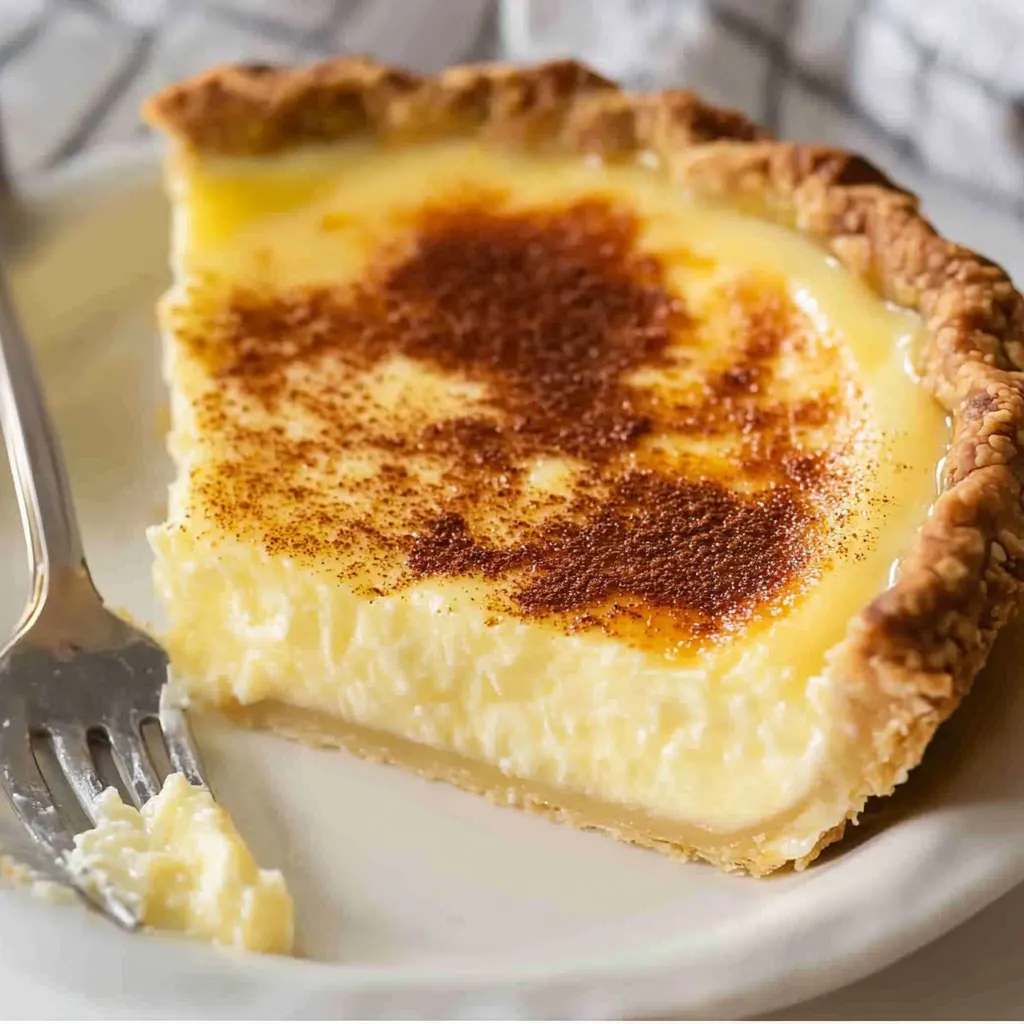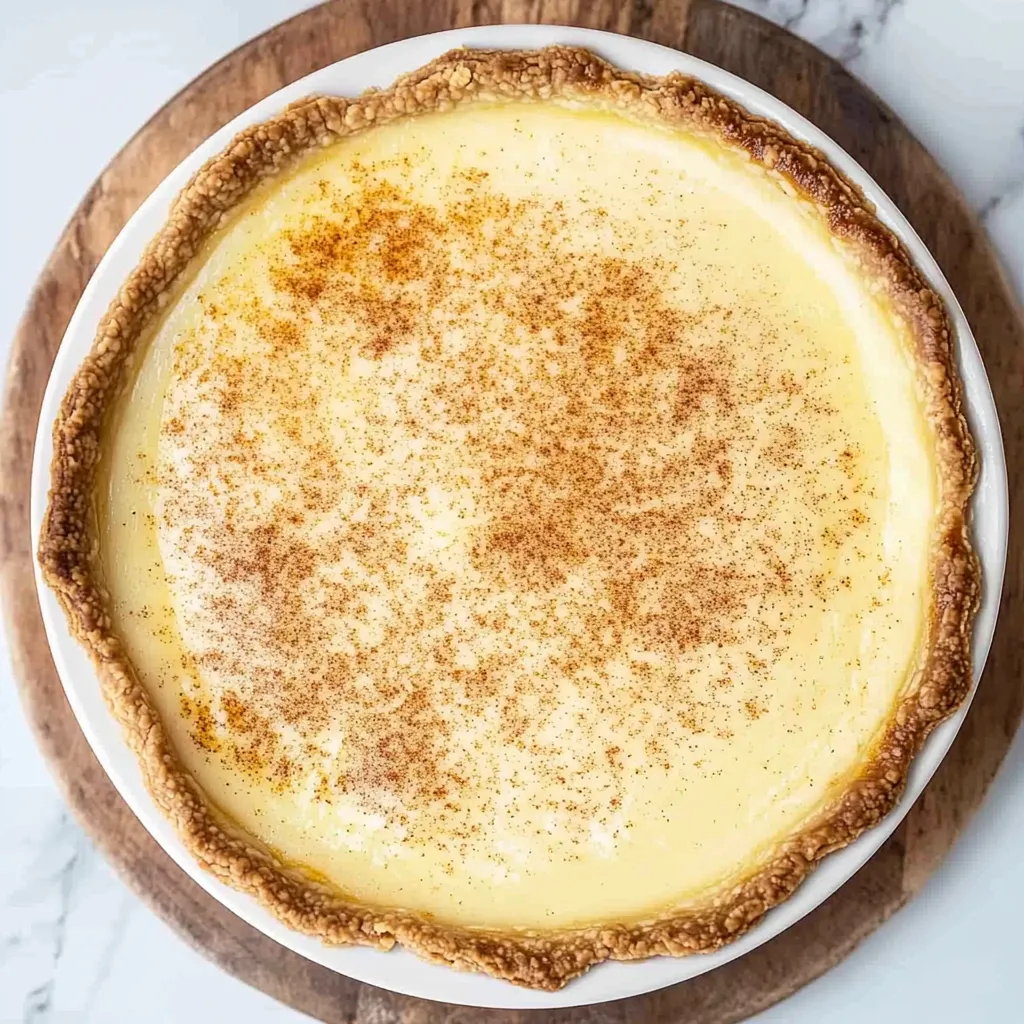 Pin it
Pin it
Egg custard pie brings together the most basic pantry ingredients to create something truly magical. This humble dessert transforms eggs, milk, sugar, and vanilla into a silky, delicate treat that's somehow both rustic and refined. The beauty of custard pie lies in its simplicity – it doesn't rely on fancy techniques or hard-to-find ingredients, yet delivers a dessert that feels special enough for any occasion. Ready in just about an hour from start to finish, this nostalgic favorite proves that sometimes the simplest recipes create the most memorable experiences.
I first made this custard pie for a Sunday family dinner when I was in a pinch for dessert. I hadn't planned anything special but remembered my grandmother making this with ingredients she always had on hand. The moment my father took his first bite, his eyes closed with that look of pure food nostalgia. "This tastes just like my mother's," he said quietly. Now it's become our family's comfort dessert, the one I make when someone needs cheering up or when we gather to celebrate. Something about its gentle sweetness and creamy texture just feels like coming home.
Ingredients & Selection Tips
- Eggs: Choose fresh, large eggs at room temperature for the smoothest texture. Farm-fresh eggs with their vibrant yellow yolks will give your custard a beautiful natural color. The eggs are the star of this show, providing both structure and richness.
- Whole Milk: Full-fat milk creates the perfect consistency. Lower-fat alternatives will work but won't deliver that same luxurious mouthfeel. The milk should be at room temperature to blend seamlessly with the other ingredients.
- Sugar: Regular granulated sugar works perfectly here. It dissolves completely into the custard, creating sweetness without interfering with the silky texture. Don't be tempted to reduce the amount too much – the sugar plays a role in the structure, not just sweetness.
- Vanilla Extract: Pure vanilla extract makes a noticeable difference in flavor compared to imitation vanilla. If you can splurge on one ingredient, make it this one. The warm, complex notes of real vanilla are essential to the classic flavor profile.
- Nutmeg: Freshly grated nutmeg provides a warm, aromatic quality that perfectly complements the custard. Pre-ground will work in a pinch, but the flavor difference is remarkable when freshly grated.
- Pie Crust: While homemade is wonderful, a good quality store-bought crust saves time without sacrificing too much flavor. Look for all-butter crusts for the best flavor.
Step-by-Step Cooking Instructions
- Prepare Your Oven and Crust:
- Begin by preheating your oven to a moderate 350°F (175°C). This gentle heat is crucial for custard – too hot and the eggs will scramble rather than set into a smooth custard. While the oven heats, prepare your pie crust by gently pressing it into a 9-inch pie plate. Work carefully to avoid stretching the dough, which can cause shrinkage during baking. Create a slightly raised edge around the perimeter by pinching the dough between your fingers. This little lip will help contain the liquid custard mixture as it bakes. For an extra layer of protection against sogginess, lightly brush the inside of the raw crust with beaten egg white. This creates a thin protein barrier that helps keep the crust crisp against the wet filling.
- Mix Your Custard Base:
- In a large mixing bowl, gently beat four large eggs just until blended – overmixing will incorporate too much air and compromise the smooth texture. Add 2/3 cup of granulated sugar, 1/4 teaspoon of salt, 1/4 teaspoon of freshly grated nutmeg, and 1 teaspoon of pure vanilla extract. Whisk these ingredients together until just combined. Now, gradually add 2 cups of room temperature whole milk while whisking continuously. The mixture will be quite thin and liquid – this is exactly what you want. Strain the mixture through a fine-mesh sieve to catch any bits of egg that didn't incorporate fully, ensuring an utterly smooth custard.
- Fill the Crust:
- This step requires some care to avoid spills, as the custard mixture is very liquid. Place a rimmed baking sheet on the bottom rack of your oven to catch any potential overflow. Place your prepared pie crust on the middle rack and carefully pull it toward you without removing it completely. Pour the custard mixture into a pitcher or measuring cup with a spout, then carefully pour it into the crust while it's still in the oven. This method eliminates the risk of spills while transferring a filled pie to the oven. Fill the crust as full as possible without overflowing – the custard will set as it bakes.
- Bake with Care:
- Gently slide the rack back into place, being mindful not to slosh the filling. Bake for approximately 35 minutes, but start checking at the 30-minute mark. The custard is done when a knife inserted halfway between the center and the edge comes out clean. The center may still have a slight wobble, but it will continue to set as it cools. The top should be lightly golden with perhaps a few darker spots where the nutmeg has concentrated. Avoid opening the oven door frequently during baking as temperature fluctuations can prevent proper setting.
- Cool Properly:
- Once baked, remove the pie carefully and place it on a wire rack at room temperature. Allow it to cool completely before refrigerating – rushing this step can cause condensation to form on the surface. Once cooled to room temperature, cover loosely with plastic wrap and refrigerate for at least 2 hours, but preferably overnight. The flavors meld and develop beautifully with time, making this an ideal make-ahead dessert. Serve chilled for the best texture and flavor experience.
 Pin it
Pin it
I've always been drawn to the nutmeg in this recipe. My grandmother taught me to buy whole nutmegs and grate them fresh with a microplane just before using. The difference in aroma and flavor is remarkable – warm, complex, and slightly floral rather than the dusty character of pre-ground nutmeg. Sometimes I'll add just a hint of cinnamon too, especially in fall, but I'm careful not to let it overpower the delicate egg flavor that makes custard pie so special.
Seasonal Variations
While the classic recipe shines on its own, subtle seasonal adaptations can create new experiences throughout the year. In spring, I sometimes add a teaspoon of lemon zest to brighten the flavor profile. Summer calls for a fresh berry garnish – the tart berries cutting through the sweet custard creates a perfect balance. Fall welcomes warming spices like a pinch of clove or ginger alongside the nutmeg. Winter holidays are perfect for a splash of bourbon or rum in the custard and perhaps a dollop of lightly sweetened whipped cream.
The versatility of custard pie makes it a canvas for subtle flavor experiments without losing its comforting essence. I've found that adding extracts like almond or coconut can create interesting variations, but always in small amounts – no more than 1/4 teaspoon – to avoid overwhelming the delicate egg flavor.
Perfect Pairings
This custard pie needs nothing alongside it, but certain accompaniments can elevate the experience. A tumble of fresh seasonal berries adds color and a tart counterpoint. A light dusting of powdered sugar creates a festive look for special occasions. For an adult dessert, a small glass of Sauternes or late-harvest Riesling creates a remarkable pairing – the honeyed notes in these sweet wines echo the vanilla in the custard.
Coffee, particularly a medium roast with caramel notes, pairs beautifully with egg custard. The slight bitterness of coffee contrasts with the sweet custard, cleansing the palate between bites. For tea drinkers, a fragrant Earl Grey or a gentle chamomile complements the custard's delicate flavor profile.
Troubleshooting Tips
Sometimes even simple recipes can present challenges. If your custard develops cracks, it's likely been baked too long or at too high a temperature. Next time, reduce the heat by 25 degrees and check earlier. If the custard seems too loose after cooling, it likely needed a few more minutes in the oven. Remember that custard continues to set as it cools, so a slight wobble in the center when removing from the oven is perfect.
My journey with this egg custard pie spans decades, from standing on a stool in my grandmother's kitchen to making it for my own family gatherings. What I love most is how it brings an instant hush to the table when served – that first creamy spoonful commanding everyone's full attention. It's not flashy or complicated, but it never fails to evoke sighs of contentment. In our busy world of complex flavors and elaborate desserts, there's something profoundly satisfying about a perfect custard pie – simple ingredients transformed through time-honored techniques into something greater than the sum of its parts.
Frequently Asked Questions
- → Do I need to refrigerate egg custard pie?
- Yes, egg custard pie must be refrigerated because of its egg content. Always chill it before serving for the best texture and flavor.
- → How do I prevent my custard pie from getting watery?
- Beat your egg mixture very well to ensure even distribution and bake until a knife inserted in the center comes out clean. Undercooking is the main cause of watery custard.
- → Can I use a homemade pie crust instead of store-bought?
- Absolutely! Either a homemade or store-bought refrigerated crust works well for this recipe.
- → What's the best way to pour the custard without spilling?
- Place your pie crust in the oven first, pull the rack out slightly, then pour the custard mixture into the shell while it's already in the oven to avoid spills.
- → Why should I brush the crust with egg white?
- Brushing the crust with egg white creates a barrier that helps prevent the liquid custard from making your crust soggy.
